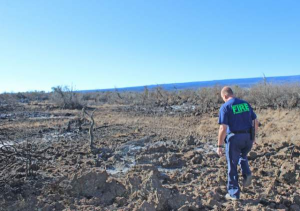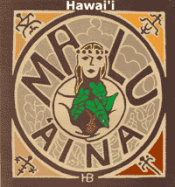News article in today’s West Hawaii Today and Hawaii Tribune-Herald newspapers
News article in today’s West Hawaii Today and Hawaii Tribune-Herald newspapers
followed by a comment I sent in to WHT online and an email I sent to the writer of the article –Chelsea Jensen.

Pohakuloa Training Area Fire Chief Eric Moller walks through a 200-acre burn area at Pohakuloa Training Area. (Chelsea Jensen/West Hawaii Today)
By Chelsea Jensen West Hawaii Today cjensen@westhawaiitoday.com
POHAKULOA TRAINING AREA — As a 200-acre brush fire continues to burn here, concern is rising over whether depleted uranium from spotting rounds used as part of the Davy Crockett program in the 1960s is being released into the atmosphere.
The fire, located within the Army’s Pohakuloa Training Area about 10 miles in on the Mauna Loa side of Daniel K. Inouye Highway, has been burning since 11:30 a.m. March 24, said PTA Fire Chief Eric Moller. It started during live-fire training within the an impact area, but a distance from areas where the Army in 2006 confirmed depleted uranium (DU) remains from spotting rounds used as part of the Davy Crockett program in the 1960s.
“This fire is well over two miles from where that weapons arc is,” Moller said, indicating the area on a map before pointing from Range 3 in a northerly direction, adding that the arc, for the most part, is within a lava flow with little to no vegetation.
To get there, the fire would have to be fanned from the south, which Moller said is unlikely given Mauna Loa towers behind and prevailing east-west winds. The flames would also have to get over a barren 1/2-mile-wide a’a lava flow.
Despite assurance from Army officials, questions and concerns are being raised by individuals about the fire and its proximity to areas where the spotting rounds that contained DU, a dense, weakly radioactive metal alloy left over from the uranium enrichment process, were fired amid the Cold War.
“It’s not the threat of the PTA fire spreading off the base that is an issue. It’s what’s blowing in the smoke and wind from that fire that’s been burning for 10 days. Pohakuloa has been bombed for 70 years with a wide variety of weapons. There is depleted uranium (DU) and other military toxins in the Pohakuloa Impact area, the amount never adequately studied despite repeated requests,” reads a letter signed by Jim Albertini, president of Malu Aina Center For Non-violent Education and Action, Clarence Ku Ching, Isaac “Paka” Harp, Cory Harden, Dr./Major Doug Rokke, former Director US Army DU project, and Dr. Carol Murry, doctor of public health.
According to the World Health Organization, people can be exposed to DU through inhalation, ingestion and contact. Inhalation is most common and occurs after the use of DU munitions in conflict or when DU in the environment is re-suspended in the atmosphere by wind or other disturbance. DU has both chemical and radiological toxicity known to affect the kidneys and the lungs. Health consequences are determined by the physical and chemical nature of the depleted uranium, as well as the level and duration of exposure.
Albertini and others say the military, Nuclear Regulatory Commission and the Hawaii Department of Health do not know where or how much DU lies within Pohakuloa.
“The people (Army) are saying there’s not enough DU up there to cause a concern, but the fact is they don’t know how much DU is up there because they’ve never done the comprehensive testing — it’s all speculation,” Albertini said Monday. “The burden is on them to allow for this independent testing because we can’t trust you.”
Albertini and others want to see air quality monitoring at the Army installation to ensure DU and other “military toxins” are not being aerosolized and dispersed by winds.
After iterating that the fire is far from areas where DU has been identified, the Army also noted that DU only aerosolizes at very high temperatures, much higher than those temperatures produced by brush or range fires.
According to Moller, a “cold fire,” like is occurring at PTA, burns around 900 degrees while a heavy metal, like DU, which is twice as dense as lead, requires much more heat to aerosolize, well over 1,000 degrees higher than the 900 degrees.
In a 2008 report, the military released results from monitoring of air quality during burning of vegetation free of DU and confirmed to have DU present at Schofield Barracks on Oahu. Soil samples from an area confirmed to have DU showed it present before and after the burn.
“The air filters collected during the test burn did not identify any increase in uranium activity concentration compared to the pre-burn air filters and no evidence of uranium depletion was found in the air filter results,” the study reads. “These results confirm that there was no measurable hazard during burning activities.”
“We appreciate the community’s interest, and we want to assure the community — especially those of us who live and work in the immediate area — that we take everyone’s safety seriously,” said Lt. Col. Jake Peterson, commander, U.S. Army Garrison-Pohakuloa. “If people do have questions about DU, we encourage them to check out our website and get the facts.”
Though the blaze continues to produce smoke, it is contained thanks to that a’a flow separating it from an area where DU has been identified, and another pahoehoe flow providing natural fire breaks, Moller said. The smoke is being generated by the fire crawling underground through duff (a layer of decaying vegetation found growing vegetation) and igniting material above ground, leaving sporadic circular burn areas separated by untouched land.
“There’s zero chance of escape,” Moller said during a tour within the burn area as a pueo glided above. The closest vegetation is more than a mile away.
He expects the fire will smolder for the next several days as firefighters cannot actively douse the flames because of the threat of unexploded ordnance within the impact area.
“We don’t go in, we don’t fight it because it’s just too dangerous,” Moller said.
Firefighters are instead focusing efforts on a 100-yard stretch of roadway to keep the fire from crossing spreading into protected areas. No endangered species, range facilities or critical habitat is threatened.
comment to article by Jim A.
The Army confirmed in 2007 that DU Davy Crockett spotting rounds were used at PTA beginning in 1960. The Army says it doesn’t know how many were fired at PTA. But an official Army Col. spokesperson, Howard Killian, testified that possibly 2000 or more spotting wounds were fired at PTA based on the number of people trained to fire the Davy Crockett weapon system. There are many DU weapons in today’s military arsenal. Have they been used at PTA as well. No one knows. What we do know is that the PTA “Impact Area” has been the site of millions of live rounds fired annually that include high explosives. Those high explosives likely have burned the DU present and turned large pieces of DU metal into DU oxide particles which are extremely dangerous if inhaled, possibly causing various cancers, birth defects, and genetic damage. The small DU oxide particles can be carried long distance by the winds and fire.
This is why independent comprehensive air monitoring needs to be done around Pohakuloa. I suspect there has been a lot more DU used at Pohakuloa than the Davy Crockett spotting rounds. Lots of other toxins as well. That’s why the military doesn’t want thorough independent testing and monitoring. If you look, you may find something that may result in shutting down the base because it is too hazardous to keep bombing it.
copy of email to article writer Chelsea Jensen
Aloha Chelsea,
Mahalo for shedding some light on the issues. I think you did a very balanced job. I only wish you were carrying my radiation monitor or an air monitor. I just sent in a comment on line. An additional point is that wherever the Davy Crockett spotting rounds were fired, that area has also seen high explosive firing on top of the DU rounds likely resulting in their being burned and turned into the far more hazardous DU oxide particles that can be blown out of the original DU range, into the larger impact area and beyond the base. Who knows how far those particles have been dispersed by high explosives since 1960 on top of DU? Like the old Bob Dylan song says: The answer is blowing in the wind!
Keep up your good work. It is much appreciated.
Jim
